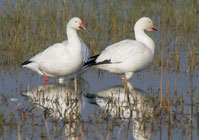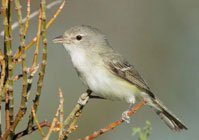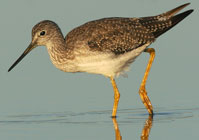Accomplishments
The CVJV partnership has earned an impressive record of accomplishment since its inception in 1988, and is making great progress towards meeting the objectives identified in its 2020 Implementation Plan.

 Bell’s Vireo
Bell’s VireoBy Jill Shirley, Outreach Coordinator
Central Valley Joint Venture

One of the early and important efforts of the Central Valley Joint Venture (CVJV) was the Cosumnes River Preserve project. This multi-agency, multi-partner project foreshadowed the unique and vital role that the CVJV would come to play in Central Valley habitat protection, enhancement, and restoration efforts.
The Central Valley once contained one of the largest expanses of riparian forest and wetland habitat in North America. Similar to the rest of the unique habitat types that once characterized the Central Valley, they have largely given way to agriculture and urban development.
Small but significant stands of valley oaks have survived along the lower Cosumnes River in southern Sacramento County. These groves cover approximately 1,500 acres, and along with the remaining riverside forests and wetlands, they provide habitat for the wildlife that still flourishes there. The Cosumnes River floodplain is a haven for tens of thousands of migratory and resident waterbirds, songbirds, and raptors, as well as a large portion of the Central Valley’s population of greater sandhill cranes.
The Nature Conservancy (TNC) was the first organization to become actively involved at the lower Cosumnes River watershed in 1984. TNC purchased a conservation easement on 85 acres of valley oak riparian forest. In 1987, with the acquisition of more than 1,400 additional acres, TNC officially established the Cosumnes River Preserve.
In 1988, Ducks Unlimited (DU) joined as a partner in the project. The joint goal of TNC and DU was to protect and restore two natural communities that had become rare in California: valley oak riparian forest and freshwater seasonal wetlands (both managed and floodplain). Land acquisition was not a typical conservation strategy for DU. The fact that they were willing to purchase property in order to protect it reflected both the importance and opportunity associated with the Preserve. It also helped build a foundation for further protection and expansion efforts in this area.
The U.S. Bureau of Land Management joined the project as a partner in 1988 with the purchase of 150 acres of wetlands. In 1990, the California Department of Fish and Wildlife, working with the Wildlife Conservation Board, secured 840 acres of valley oak woodland and seasonal sloughs, followed by conservation activities of the Sacramento County Department of Regional Parks in 1993. The California Department of Water Resources became a partner in 1996, with the purchase of agricultural land at the southern border of the new preserve. Additional lands have since been added, including the 9,000-acre Staten Island Ranch by TNC in 2001.
In the early days of the project the CVJV was still in its infancy. But the same partnership that was growing at the Preserve was growing on the CVJV Management Board. The role of the CVJV unfolded in a manner that would come to define its unique contribution to the conservation of waterfowl and wetland habitat in the Central Valley.
According to Chris Unkel, who worked on the project on behalf of TNC, the role of the CVJV’s 1990 Implementation Plan was crucial. “The fact that there were habitat goals and objectives tied to each basin within the Valley helped people to focus on acquisitions and projects that related to the Plan. Fulfillment of the Plan was something that the partners were very invested in, and they considered the Preserve to be a ‘flagship’ model of collaborative conservation.” In the words of former CVJV Coordinator, Dave Paullin, “Money gravitates to a good idea”.
Another important development was the role of science. The Joint Venture brought researchers to the Preserve, which helped establish the scientific component of the CVJV program. The Preserve became a laboratory for the study of waterfowl and related issues. The relationship of agriculture and flood control to habitat quality, understanding the value of flood plains to salmon, recognizing the impact of hydrology, realizing the compatibility of fish and waterfowl conservation; these and other aspects of land management culminated in projects at the Preserve.
Perhaps the greatest contribution of the CVJV was providing a forum for the many groups working at the Cosumnes to assemble and talk about projects, highlight progress and innovations and share research results. The Cosumnes River Preserve became a regular agenda item at Management Board meetings and it became a venue to discuss and disseminate information. According Unkel, Board meetings “provided a forum for keeping the concepts alive and inspiring, bringing in new partners and participants and exchanging ideas, successes and accomplishments. The public outreach and educational aspects also grew. It was a project with real buzz and excitement. It wouldn’t have happened without communication – and an environment of cooperation and opportunity created by the CVJV.”
Today, the Preserve consists of almost 46,000 acres of wildlife habitat and agricultural lands owned by seven land-owning Partners. It continues to inspire the thousands of visitors who enjoy the wildlife that these habitats provide.
The CVJV partnership has earned an impressive record of accomplishment since its inception in 1988, and is making great progress towards meeting the objectives identified in its 2020 Implementation Plan.

Follow these links to learn about some of the important bird conservation work happening in California's Central Valley.
